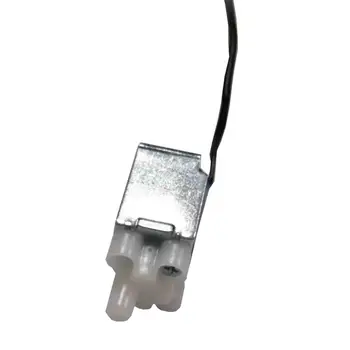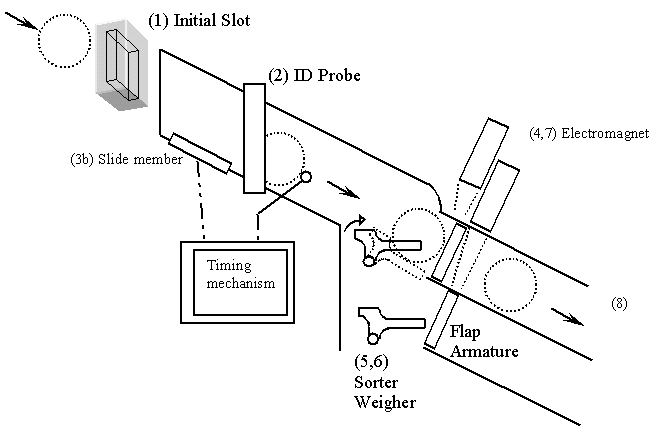Solenoid Slot


M8 x 1.25, motor term. M8 x 1.25, switch term. Male spade, plunger slot length 10.5mm. Solenoid coils are rated to operate from 12-V to 24-V DC and 110-V to 230-V AC systems with a power consumption ranging from 8 to 20 W. Electromechanical solenoids consist of an electromagnetically inductive coil wound around a movable steel or iron slug called the armature, or plunger.
A solenoid door lock is a remote door locking mechanism that latches or opens by means of an electromagnetic solenoid. In most cases, the actual locking mechanism of a solenoid door lock will be identical to a conventional key-operated example. The only difference between the two is the inclusion of a low-voltage solenoid in the mechanism, which pulls the latch back into the door when a push button or other controller is activated. The latch will then be retained in the door for as long as the button is pushed, or, in the case of a latching solenoid, indefinitely until the button or controller is activated again. These types of door locks are used extensively in remote security access and automotive doors.
Most door locks work in one or two basic ways. In the case of access doors in buildings, a latch or pins in the lock mechanism located in the door leaf are pushed into a hollow compartment or socket in the frame, thereby preventing the door from being opened. A fairly simple cam arrangement allows the latch to be withdrawn and retained in the lock mechanism when the door is unlocked. Car door locks usually function in a slightly different manner and feature a slotted cam which locks over a latching bar on the car body. An arrangement of levers and linkages is used to lift the cam and open or lock the mechanism.
The solenoid door lock, on the other hand, makes use of a static wire wound coil and a moving armature or plunger to perform the work of the key and linkages in conventional locks. The coil is wired into a circuit, which will include a low-voltage, direct-current (DC) power source, and at least one control input such as a push button. When the control is activated, electric current flows to the coil, energizing and creating a strong magnetic field around it. This magnetic field attracts the armature or plunger, causing it to move rapidly towards the coil. The locking mechanism latch or cam is attached to the armature or plunger via an actuator arm and is consequently pulled out of the locking position.

In the case of some security access doors, the solenoid door lock will remain active for a couple of seconds courtesy of a built-in delay circuit allowing time for the door to be opened. It may also be kept active by an operator holding down the control button until the door is opened. When the power is cut to the solenoid, the latch resets and the door locks again when closed. Where the lock is meant to stay open for protracted periods, a latching solenoid may be used. These solenoids include a set of permanent magnets at the rear of the coil which hold the plunger in place, allowing power to be cut to the solenoid door lock coil, preventing overheating and unnecessary power drain.
A solenoid door lock is a remote door locking mechanism that latches or opens by means of an electromagnetic solenoid. In most cases, the actual locking mechanism of a solenoid door lock will be identical to a conventional key-operated example. The only difference between the two is the inclusion of a low-voltage solenoid in the mechanism, which pulls the latch back into the door when a push button or other controller is activated. The latch will then be retained in the door for as long as the button is pushed, or, in the case of a latching solenoid, indefinitely until the button or controller is activated again. These types of door locks are used extensively in remote security access and automotive doors.
Most door locks work in one or two basic ways. In the case of access doors in buildings, a latch or pins in the lock mechanism located in the door leaf are pushed into a hollow compartment or socket in the frame, thereby preventing the door from being opened. A fairly simple cam arrangement allows the latch to be withdrawn and retained in the lock mechanism when the door is unlocked. Car door locks usually function in a slightly different manner and feature a slotted cam which locks over a latching bar on the car body. An arrangement of levers and linkages is used to lift the cam and open or lock the mechanism.

The solenoid door lock, on the other hand, makes use of a static wire wound coil and a moving armature or plunger to perform the work of the key and linkages in conventional locks. The coil is wired into a circuit, which will include a low-voltage, direct-current (DC) power source, and at least one control input such as a push button. When the control is activated, electric current flows to the coil, energizing and creating a strong magnetic field around it. This magnetic field attracts the armature or plunger, causing it to move rapidly towards the coil. The locking mechanism latch or cam is attached to the armature or plunger via an actuator arm and is consequently pulled out of the locking position.
Solenoid Solutions Erie Pa
In the case of some security access doors, the solenoid door lock will remain active for a couple of seconds courtesy of a built-in delay circuit allowing time for the door to be opened. It may also be kept active by an operator holding down the control button until the door is opened. When the power is cut to the solenoid, the latch resets and the door locks again when closed. Where the lock is meant to stay open for protracted periods, a latching solenoid may be used. These solenoids include a set of permanent magnets at the rear of the coil which hold the plunger in place, allowing power to be cut to the solenoid door lock coil, preventing overheating and unnecessary power drain.